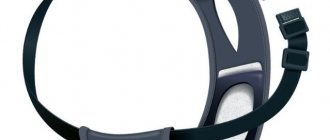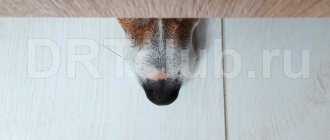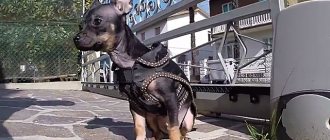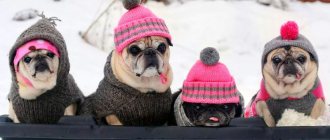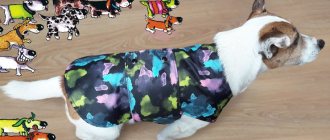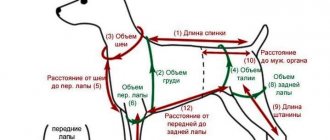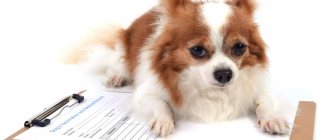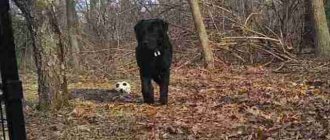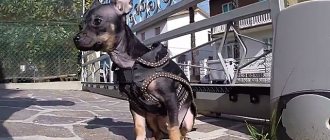Harnesses are used not only for small dogs, but also for large ones. Store-bought products are often poorly made, and therefore, if a large dog jerks or runs suddenly, the weak fastening may break, and this will lead to not very good consequences. You can sew a harness with your own hands even for a shepherd and other large dogs.
What is a harness and why is it needed?
For dogs of large and service breeds, a harness is the trainer’s best assistant; you cannot do without it at dog competitions. If you have a pet of a decorative breed (Yorkie), the harness will make the walk comfortable for all participants in this pleasant process. You can make it yourself using durable materials: leather and braid. Harness for domestic dogs must be equipped with a carabiner and buckle. It is important that the device does not have a lot of weight.
Purpose
Note! The pet should not always be in a walking harness. When the dog moves, it has a different center of gravity than when walking with a collar. Therefore, when you have to walk without equipment, the animal does not like it.
In order to choose the right material, you need to decide for what purpose it is selected. For example, it is best to use nylon and cotton to hold a leash while walking. Leather is not a good choice in this case, since it needs to be used in dry weather, and when exposed to moisture it quickly loses its shape. If we talk about the classics, the simplest model consists of two leashes sewn together, fixed at four points.
For small breeds, the harness also has a handle to make it easy to lift your pet. For puppies, equipment should be soft and durable. For those who are preparing a dog for an exhibition, the harness is decorated and decorated with rhinestones and other accessories. For small indoor dogs, holding leashes make them not only convenient, but also beautiful.
Why is the dog resisting?
The reasons may be as follows:
It is necessary to stop following the dog and also pulling the leash.
What to do then? The answer is simple: if the owner feels that the animal is starting to change pace or direction, then he should stop and encourage the pet, pointing out the correct movement. Very often, people fall into the trap of thinking an animal is stupid, but getting offended when it doesn’t do the right thing. The most correct option is to establish emotional contact, severity and respect.
You can also purchase a leash controller for dogs, which is perfect for naughty dogs. Such a device not only does not harm the animal, but also helps it get used to an ordinary leash.
Many people are interested in the question: how much does a leash for a dog of this kind cost? Currently, prices for leash controllers are affordable for everyone. On the contrary, you should get rid of tape measures.
If the owner has several pets, then it is worth purchasing a leash for two dogs - they will behave more submissively. This may seem strange, but in such an environment animals tend to focus on maintaining tempo and direction. Separate leashes, on the contrary, promote dog play.
How to cut
Despite the large assortment of harnesses for large, medium and small breeds of dogs, sometimes you want to make a harness for your pet of the desired shape and size with your own hands. Moreover, this is very easy to do thanks to the availability of a variety of step-by-step instructions and diagrams online that allow you to sew a product to suit every taste. Some manage to do this so well that they take part in master classes.
First you need to take measurements, and then select the fabric. It is better to give preference to fabrics that are used for factory production of harnesses. Mixing them is also allowed. For example, you can combine the use of leather and nylon.
Important! The combination of synthetic and natural fabrics will provide the product with high strength and lighten the weight of the equipment.
Speaking of light weight, paracord collars are characterized by high strength and low weight. For small dogs, such as Yorkies, pugs, dachshunds, and Pomeranians, you can use velor, which is attractive in appearance and inexpensive.
DIY dog harness: step-by-step instructions
There are a large number of options for cutting and sewing a dog harness. The classic option is to sew a pair of leashes together and fix them at 4 points.
Step-by-step instruction:
- Take the braid (it is better to use durable material) and take a measurement using a sewing meter. You need to get the length of the braid that corresponds to the volume of the dog’s body.
- The resulting result is multiplied by two.
- Take a good quality cotton fabric and then cut a strip from it that will match the length of the braid.
- Place the cut strip of fabric between the sides of the braid and machine sew the side seams. It is best to use nylon threads.
- Then sew on a strap that fits on the owner’s hand.
- Make loops along the edges and then secure them with a knot.
- On the side of the ring, leave space for the hem, and on the side of the buckle, for the buckle and hem.
- Secure the rings and buckle onto the loops.
It is necessary to sew, or rather sew together elements of the equipment, with high quality, otherwise the product may tear after the first walk with an active pet that loves to pull.
Important! Fastening hardware must be of high quality.
How to sew a harness with your own hands: step-by-step instructions with video
With little sewing skills, you can make a harness yourself. You need to take durable material and soft fabric for interior decoration, carabiners and one-piece rings. After completing the necessary measures to take measurements from the dog, they begin making the harness.
- Riding, running and cargo harnesses. These accessories for dogs are sewn identically using the same patterns, only the purpose and methods of attaching the leash are different. The required materials for sewing are leather, nylon, jeans and tarpaulin.
- First you need to measure the size of your pet.
- Then measure out double the length of the braid.
- Cut strips from old denim fabric.
- Then we sweep away the denim laid between the strips. Needs stitching.
- You need to sew an auxiliary belt on the harness.
- We place loops at the edges of the braid. Here you need to strengthen it well and stitch it up to 8 times. The strips themselves also need to be stitched in the center once.
- You need to take a nylon thread and make loops with their installation in a knot, necessary for attaching the carabiner.
For stronger stitching, use a zigzag stitch. This will allow the product to stretch and not tear.
In the same way, you can make a harness that will be suitable for walking, diversifying it with finishing fabric and decorative elements.
To read: Dwarf Minskin: history of the origin of the breed
Huskies have been a very popular dog breed lately. Living in urban environments, we must not forget that they belong to sled dog breeds and must receive a certain amount of physical activity. Dog sledding and various competitions will help the animals always be in shape.
Main types of dog harnesses and their classification
Taking into account the size of the animal, as well as the purpose of using the equipment, types of dog harnesses are classified into the following categories:
- Walking shoes are used in everyday life (when walking with an animal). Durable and wear-resistant material is used to make this accessory. For example, you can use leather or nylon.
Main types
- For small puppies. The dog must not get out of the harness. For them, ammunition is specially selected strictly according to size. It is best to accustom a puppy to an accessory from a very early age, approximately 6 to 9 months. These models are comfortable and lightweight.
- For very tiny puppies. Such products can be found in any store. They are presented in a large assortment. Many of them are equipped with handles on the back. This will make it easy for the owner to pick up the puppy.
- For large dogs. Using a similar model, even a child can walk a large breed dog.
In what cases are walks contraindicated for cats?
- You cannot walk a cat if it does not have all the necessary vaccinations, because during a walk it can become infected with some kind of infection. It is also recommended to wear a special flea collar.
- You should not walk small kittens, because their immunity is not yet fully formed, they are much weaker than adults. Until the age of 5 months, walk with the kitten, wearing a harness, only around the apartment.
- If the cat is already more than 10 years old, and you have never walked with it before, then you should not start. A walk will become extremely stressful for an elderly animal, which will negatively affect your pet’s health.
- It is not recommended to walk cats that have recently undergone surgery or any illness, pregnant cats, or before or during the onset of estrus.
- If your pet is overly aggressive or cowardly, does not get along well with others, with strangers and with other animals, then most likely it will be very difficult to accustom your cat to a leash. Surely the animal will react to such an innovation with extreme hostility.
- If you know how to put a leash on a cat so that it causes it a minimum of discomfort, and you know how to take into account the individual characteristics of your pet, then the walk will bring only pleasant impressions to both you and your cat - you will be calm about the safety of the animal, and your pet will probably enjoy it the opportunity to explore new horizons.
When buying a harness that has a complex type of weave, the owner does not yet understand how to use it correctly
and put it on your pet. Typically, a harness looks like a leash, which is combined with a belt that goes across the entire area of the pet's upper chest.
Various product options
Trying to ensure maximum convenience and safety, caring breeders have come up with several options for long leashes, dividing them according to their intended purpose. Therefore, the following types are distinguished:
for walks. These harnesses are available for small breeds such as Dachshund, Spitz, etc., and for large breeds;- for sledding and towing;
- leashes with weights (weights), which are used to train and maintain the physical shape of the dog;
- created for auxiliary medical purposes, the task of which is to relieve the stress from the pet’s limbs as much as possible;
- for puppies up to 6 months, preventing paw dislocations and promoting the development of the animal's pectoral muscles.
Also, these products are designed to take into account the individual characteristics of the age and breed of dogs, this is also taken into account in the form of leashes.
Therefore, according to their configuration, they are:
- H-shaped. They are two loops that fit over the head and front paws. A connecting strip is sewn between the loops.
- Reminiscent of 8. They are very similar to the previous ones except that they do not have a bar. This model is considered to be the safest as it prevents the dog from suffocating.
- Vests.
- V-shaped. They resemble the letter V on the dog’s back.
The variety of shapes will allow you to choose a shape for your pet that will not restrict his movements, put pressure on him or cause other inconveniences, while maintaining the maximum level of safety.
Types of harnesses for domestic dogs
DIY hamster wheel - step by step instructions
There are many types of this accessory, so in order to choose or sew the right one, you need to study the pros and cons of each.
Medical
Medical equipment differs from the standard in its design and is intended for pets with injuries or partially paralyzed. Such harnesses resemble vests in appearance, occupy two-thirds of the body and are attached near the hind legs, which reduces the load on the hind legs.
Medical harness for dogs
For puppies
For puppies less than six months old, special harnesses are designed that allow you to monitor the formation of the pet's body and prevent improper formation of the limbs.
Important! Choosing the right product according to your pet’s figure promotes better development of the chest.
Puppy harness
Riding
Riding harnesses have a special design, which is based on two belts that run along the dog’s back and are attached at four points. A rope is attached to the belts, connecting the team and the pet. Thus, the load is distributed evenly along the body, without squeezing the cervical vertebrae, and the hind legs are free.
Important! The use of such riding equipment does not cause inconvenience when running, and at the same time allows the owner to conveniently control the team.
Freight
This type of harness is designed for training pets. Weight harnesses promote the development of the thoracic spine as well as muscles. In addition, they improve the dog’s health and make it possible to use them to move light loads during walks. Thanks to the equipment with a spacer, the load is evenly distributed throughout the animal’s body.
Weight harness
Walking
Walking harnesses are the basis for securing the leash. Such products are comfortable, suitable for dogs that like to pull and do not injure the neck when jerking. In addition, this variety is suitable for pets who have previously been injured.
With the help of walking equipment, you can accustom your dog to physical activity, thanks to the provision of removable elements that make it possible to regulate the load.
Walking harness
Cross-country
The design of a running harness is similar to a riding harness, or rather, it is a kind of modification. The straps pass through the pet's back, and the leash is fixed to the croup. This protects the dog from injury during a walk due to sudden jerks. This equipment is made to order by craftsmen for pets who practice canicross.
Running harness
Main and lining material
The main material for sewing can be nylon. It is advisable to make a model combined from leather and nylon. For decorative breeds, it is recommended to take a softer material, for example, velor.
Application of base and lining material
It is convenient to sew harnesses with your own hands, since you can mix materials. Natural fabric in the form of a lining will give the product strength and also provide the animal with an increased sense of comfort. The lining fabric should not only be natural, but also soft, since it comes into contact with the pet’s skin.
Important! The material should absorb moisture well. Felt, fleece, flannel, and jeans are perfect for lining.
Rings for fastening
Metal carabiner rings are used for fastening. The fastenings must be strong. It should be borne in mind that the lighter the accessory, the more convenient and comfortable it is for the dog. In addition, the fasteners should not only be strong, but also comfortable. The best option is to make several fasteners.
Braid
If there is no nylon cable, then you should prepare a medium-width nylon braid. To strengthen it, you can use fabric from old jeans. All sections of the braid are melted using a lighter. The braid is thinner than leatherette, so it is reinforced. To do this, the dimensions are multiplied by four, two belts plus double braid.
Taking measurements
To ensure that the dog is comfortable and that the harness does not rub on one side and does not dangle on the other, a do-it-yourself harness pattern for a small/large dog is done as follows. The step-by-step master class includes measuring the product using an ordinary tailor's meter.
Important! To make a pattern for a harness for a cat or dog with your own hands, you need to measure the circumference of the chest at the widest point - behind the elbows of the front legs.
The main measurement is the width of the back from the beginning of the withers to the base of the tail. The neck circumference is measured at the place where the collar is usually worn. After this, before writing down the size, you should add 2 cm to the resulting figure so that the equipment is slightly loose and does not restrict movement.
How to take measurements correctly
How to sew an accessory yourself
Let's turn to how to make a dog harness with your own hands. After all, anyone can sew a harness. Professionals can go further and pamper their pet with an unusual accessory that they knitted with their own hands.
- Taking measurements of your pet.
Regardless of the chosen method of making your own harness, you have to start by taking measurements . Only correctly taken measurements will help you sew an accessory that is ideal for your pet.
The chest circumference is taken behind the dog's front legs at the widest point. To the resulting value you need to add 2 centimeters for a loose fit.
The girth of the neck is determined in the place where the animal usually wears a collar.
The length of the pet's back is measured from the withers to the base of the tail.
- Choice of material for the product.
The next step is choosing the material . Strength, wear resistance, softness and ease of cleaning - these are the requirements for harness fabric.
Cotton and linen are considered the most suitable - they breathe well, nylon is easy to clean and does not get wet , and felt retains heat.
Don’t forget about rings, clasps, carabiners and Velcro, which will help the owner to easily remove and put on the harness on the pet.
- Constructing a pattern and sewing a product.
Having completed all the preparatory work, we proceed to constructing a pattern for the product. Don't forget about 2cm seam allowances on all sides. The resulting pattern will form the basis for cutting the product onto the fabric.
When can you use ammunition with weights?
The period when you can put on a weighted harness depends primarily on the breed of your pet and the nature of your training. Some people are advised to use weights from a year old, others - from a year and a half, and others - not earlier than two years. Therefore, before buying this harness and starting to use it, the owner must consult with an experienced trainer or at least a veterinarian, and then strictly follow all the recommendations received.
And most importantly, a do-it-yourself dog harness with a weight should be sewn by knowledgeable people, because a huge number of nuances should be taken into account, and if something is missed or not taken into account, then the health of your pet will suffer from one wrong step. You need to be very careful and competent in distributing the weight of the load. A cargo harness for dogs requires exclusively individual tailoring, specifically for your dog, in order to avoid big problems in the future. It is better to avoid sewing such a thing yourself if you have little experience.
Various finishes
The finishing will add uniqueness to the harness. The imagination of a master can turn an ordinary object into a masterpiece. Decoration with rhinestones, bows, appliqués, and embroidery are appropriate in DIY harnesses for small dogs.
Jewelry gives the product and pet a glamorous look. But when finishing, for example, a harness for a shepherd dog with your own hands, you can use blocks and buttons. Such a harness, like its owner, will take on a brutal, strict appearance.
Large and strong animals can be “rewarded” with harnesses equipped with weights. This accessory is often used when there is a lack of muscle mass. Weight harnesses help restore it and strengthen the dog's back . It is better to entrust the sewing of these harnesses to professionals, since during their manufacture it is necessary to take into account a large number of various nuances that allow the harness to be safely used by your four-legged friend.
Sewing instructions
Do-it-yourself harness for a cat - the pattern is made in the same way as for a dog. To get a cat or dog accessory, you need to follow these steps:
- Initially, you need to take measurements using the method described above. After this, you will have to make a pattern, taking into account the seam allowances. If nylon is used for sewing, then the allowance will be 2 cm. If leather is used, it is necessary to leave approximately 5 mm for the seams.
- The pattern must be placed on the selected lining material and the lining must be carefully cut out. You need to make a stitch along the inside of the future harness.
- Having attached the pattern, the product must be opened around the entire perimeter and a soft braid must be sewn on. On the straps you will also have to make stitches on the outside.
- Next you need to assemble the product. Steel rings should be attached to the back. In order to make an adjustable leash, you will have to attach the rings to the straps.
- The next step is choosing the decor of the product. For small puppies, you can use bright stickers, bows, multi-colored pebbles, and beads.
Correct tailoring of the product If you wish, you can learn how to make a pattern for a bed for a cat or dog.
Unusual sleds for pets
These are the so-called vest harnesses. These unconventional accessories have recently been widely used during the cold season. They not only serve as a holding device, but also warm the animal on frosty days. These harnesses are easy to make.
The pattern of the product is one-piece. It can be easily found on the Internet. It can be easily adjusted to the size of your pet. In order not to spoil the material, it is recommended to fit the pattern on a fabric that you do not mind ruining.
After the pattern has been verified in all respects, it can be transferred to the main fabric. We bend the pattern lengthwise if it is full-size. Fold the material in half and apply the middle of the pattern to the fold of the fabric. We mark the fabric along the contour of the pattern, taking into account that the pattern already takes into account allowances for a loose fit.
Do not forget that the vest is sewn with a lining , so for the wrong side we select soft, warm natural or breathable synthetic fabrics. Linen or cotton works well.
Place the main and lining fabric right sides together. We sew the harness along the entire contour, leaving a small area on the chest unsewn. Let's turn it through to reveal the product. The remaining unstitched area will be sewn inconspicuously by hand.
After all the seams are stitched, Velcro is sewn onto the straps at the neck and chest to regulate the fit of the harness.
There are two rings on the back that will serve as a place to attach a leash. It is most convenient to attach the rings to a braid, which is very easy to sew to the back of the vest. This way the product will look aesthetically pleasing.
Manufacturing methods
Every cat owner can easily find harness patterns and sew it at home. To do this, you will need to select one of the available options and strictly follow the instructions provided.
From old jeans
You can use old clothes or worn jeans to make a useful accessory. In this case, you will need fabric from the legs and a belt.
Items required for work:
- unused jeans;
- sheet of cardboard;
- scissors;
- needle and thread;
- button;
- rivets;
- tailor's centimeter.
Before starting work, you need to take measurements of your pet. In order to make a harness, you will need the girth of the animal's neck and chest.
Following actions:
- Individual details of the future product are drawn on a sheet of cardboard. In this case, it is important to accurately maintain the dimensions that correspond to the measurements taken.
- Using scissors, cut out the blanks and transfer them to denim.
- Fabric parts are produced in the same way.
- They are sewn by hand using short stitches. The thread should be dense and strong so that the seams do not come apart while walking with your pet.
- The loops intended for the torso and neck are connected to each other using a fabric jumper. It is sewn to both parts of the product with dark threads.
- A leash is cut out of the same material. Its length should be at least one and a half meters and width - 3 cm.
- A button is placed at one end of the workpiece.
- A rivet is installed approximately in the middle of the leash.
- The product part is threaded through a fabric jumper and secured with a button.
- For greater reliability, add another rivet.
We invite you to read: Toxoplasmosis in cats: causes, symptoms, treatment and prevention
Assembling a harness from leather is as easy as from fabric. It is important to consider that such material can only be used to create a summer version. A more closed winter leather accessory will be too heavy, so the cat will experience discomfort.
Materials and tools:
- 3 thin leather belts;
- rings;
- buckles;
- carbine;
- scissors;
- awl;
- thick needle;
- strong threads.
Step-by-step instruction:
- First of all, pick up your pet and take measurements. To work, you need to know the girth of the chest (at the widest point) and neck.
- In accordance with the obtained dimensions, 2 parts are cut from the strap. At the same time, do not forget to leave allowances of 2 cm.
- From another leather belt, a piece is obtained that is necessary to fasten the two main structural elements.
- The third strap is used to form a leash. For a small pet, a length of 1.6 m will be sufficient.
- At the next stage of work, they begin to connect all the parts into a single structure. To do this, take thick threads and a thick needle and alternately sew the jumper to one and the second loop.
- A carbine is attached to the future leash.
- A loop is formed and sewn on the opposite side, the size of which should be no smaller than a person’s fist.
- A hole is made in the strap with an awl, and then the leash is attached to the harness.
If a person is making a harness for his pet for the first time, then it is better to choose this option. It is interesting because you don’t need to have any knowledge or skills to do the job. In addition, the finished product almost never causes irritation to the animal’s skin or problems with the fur.
To work you will need:
- a piece of fleece fabric;
- a piece of raincoat fabric;
- checkered notebook sheet;
- braid;
- strap;
- rubber;
- lock;
- fastening elements;
- decorative ribbon;
- tailor's centimeter;
- scissors;
- needle with thread.
Correct sequence of actions:
- Take the finished accessory and transfer all its dimensions onto a notebook sheet. To simplify this work, you can take graph paper.
- The workpiece is cut out with scissors, applied to the raincoat fabric and secured with pins or binders (paper clips).
- After this, carefully transfer all the details onto the fabric.
- The paper blanks are removed, and parts are cut out along the drawn lines.
- All the same actions are performed with a piece of fleece fabric.
- The location of the braid is marked on the material and then stitched.
- The finished element will be located along the cat's spine, so an additional layer of fabric is sewn here. Thanks to this, it will be possible to avoid strong friction of the material against the animal’s fur.
- A small loop is left at the edge of the braid, into which a special ring is threaded. It is necessary in order to securely attach the finished product to the leash.
- The neck is made from a piece of raincoat fabric.
- An elastic band is sewn along its perimeter, which will allow you to change the diameter of this element.
- For decoration, braid is used, which is sewn to the lower and upper parts of the neck.
- The finished part is attached to the base, bending the edges inward.
- Carry out a test fitting and check the accuracy of all sizes.
- After this, they begin to make the leash. For it, take a leather strap and cut off a part of the required size (no more than 1.5 m).
- The edge is stitched and decorated with braid.
- The leash is attached to the installed ring and the reliability of the connection is checked.
- Decorative tape is sewn to the edges of the finished product.
- The harness is decorated with various objects (rhinestones, stones, bows, etc.).
A harness is a must-have item that every cat owner should have. Finished products can be bought at any pet store, but there is no guarantee that they will suit your pet. The best option would be to make a leash for your cat with your own hands. If you avoid mistakes and choose the dimensions accurately, your pet will like this piece of equipment.
Knitted clothes
If you are not comfortable with a needle and thread, but are great with knitting needles, then we hasten to please you - knitted clothes for dachshunds are easy to make and practical, just like those made from fabric. For this work, 200 g of any yarn of medium thickness will be useful: perhaps you have a ball lying around from a previously knitted scarf or sweater, or you purchased a warm woolen thread especially for this case. Here are some tips for creating a stylish sweater:
Start knitting it from the neck.
- On the back side, reduce the number of stitches to avoid the formation of folds and wrinkles.
- The sleeve knitting technique is similar to the technique for the fingers of gloves.
- Decorate the finished sweater with decor or add buttons.
The variety of yarn colors allows you to create not only clothes that are comfortable for your dachshund, but also a whole work of design art.
Advanced knitters can afford to give their pet a whole costume: a warm blanket or sweater and boots in case of particularly severe frosts. An evening of work will be fully repaid with doggy joy.
Features of sewing a riding harness
Harnesses for riding and kits for skijoring, bikejoring, cani-cross (towing belts, pulling, harnesses) are an excellent option for joint active recreation and sports with your dog. Suitable for different seasons and people with different levels of physical fitness (in winter, a dog can pull a skier, in summer - a cyclist or a person running behind it).
Note! Unlike power work, for which weight harnesses are used, riding gear is designed to handle light weights over long distances.
Recognized
FCI recognized breeds include:
- husky;
- Samoyeds;
- Alaskan Malamutes;
- Greenland sled;
- Chukotka sledding
Siberian Husky
Siberian Husky
The Siberian is medium in size, has a thick undercoat and dense coat. Its powerful frame allows it to easily transport small loads.
The Siberian Husky is not suitable for city life, as its restless nature and independence become the reasons for the destruction of the apartment.
Prices for puppies start from 20 thousand, reaching up to 50 thousand rubles, depending on the class.
Animals are characterized by:
- friendliness and complete lack of aggression towards people;
- cleanliness, keeping maintenance to a minimum;
- loyalty and gentle disposition.
The pet is prone to escape, so it always tries to undermine or break off the leash.
Samoyed husky
Samoyed husky
Samoyed huskies have 3 types of head structure:
- fox;
- wolfish;
- bearish.
According to their living conditions, they are similar to huskies, so they need long walks, a spacious enclosure or a large area of a private house that provides the opportunity for free walking.
Prices for puppies start from 10 thousand, reaching up to 35 thousand rubles, depending on the class.
Animals are characterized by:
- friendliness and complete lack of aggression towards people;
- playfulness, which allows you to maintain a childish disposition right up to gray hair;
- loyalty and gentle disposition.
Do not try to train your pet to be a watchdog. He lacks this skill.
Alaskan Malamute
Alaskan Malamute
Malamutes are among the largest representatives of the section. The parameters of an adult pet reach 64 cm and 43 kg.
Alaskan dogs are not suitable for workaholics, as they require constant attention and long periods of walking. Like other representatives of the breed, they should be kept in a private home, but some breeders can cope in apartment conditions.
Prices for puppies start from 12 thousand, reaching up to 30 thousand rubles, depending on the class.
Animals are characterized by:
- silence (the pet rarely makes a voice by barking);
- good nature and high intelligence, allowing you to easily get along with other pets and quickly remember new commands;
- stubbornness and leadership habits, causing difficulty in training for beginners.
The tendency to dig holes is determined by innate instincts inherited from the ancestors. Aboriginal dogs ate rodents, extracting them from underground.
Greenland sled
Greenland sled
Greenlanders are considered rare and ancient representatives of sled dogs. The age of the animal is estimated at many millennia, going back to the time before the advent of the new era. An adult animal reaches 32 kg in weight and 64 cm in height.
The average cost for a puppy is about 42 thousand rubles.
The pet requires systematic physical activity, including carrying cargo and transporting people in harness. Animals are characterized by respect for the leader, so they recognize only one owner as the main one.
Dogs are independent, endowed with protective qualities and do not like restrictions on their freedom. Without proper experience, you will not be able to cope with a stubborn pet.
Strict breeding requirements complicate the work of breeders and explain the small number of existing nurseries.
Chukotka sledding
Chukotka sledding
The dog is of medium size, well-developed muscles and dense coat, which allows it not to freeze in the snow.
Such animals are not suited to the life of a lap dog. Without painstaking work, the pet begins to waste away.
Despite the restraint in showing affection and expressing love, the pet is always ready to protect its owner, regardless of the degree of the impending threat.
It is not easy to acquire such a pet, since the only official breeder is located in Karelia, and the cost is hidden from public access.
Features of the Husky breed
The Siberian Husky is a dog breed that has become very popular recently among pet lovers. A descendant of northern aboriginal dogs, the husky has all the qualities of a service dog, which are in perfect harmony with devotion and self-sacrifice. At the same time, they also need care and attention. The genetic code of the breed suggests its use in moving and driving. In other words, the husky is a service dog, namely a sled dog.
Husky is bred artificially. Dog breeders tried to take the best traits from their ancestors - endurance, patience, efficiency, devotion. Dogs of this breed rarely bark and only for business. But in driving they have practically no equal, especially when several individuals are harnessed to the cart. Huskies can and love to work in a team, their movements are coordinated and harmonious. It’s nice to watch running dogs, and riding in such a sled is a dream for lovers of lightning-fast riding.
Modern urban conditions cannot always use the innate characteristics of an animal for its intended purpose. However, without exercise, the dog will eventually feel unwell and may become ill. Dog handlers recommend spending more time outdoors with your pet, giving it the opportunity to run around to its heart's content. But the breed realizes itself best in sledding sports.
To practice sports discipline, a special harness is required. The main item of the attribute is a riding harness for a husky. It is convenient, comfortable and helps the dog evenly distribute its forces when moving. A riding harness should be comfortable, first of all, for the dog.
Rules for putting a harness on a pet
Putting an accessory on a pet is a difficult procedure at first. It is recommended to choose models with multiple fasteners. Before putting a harness on your pet, you should calm your dog. That is, this action should not cause unpleasant emotions, and in addition, the animal does not need to raise its paws.
How to properly put the product on your pet
The process of creating a harness
The process of creating a traditional rat harness involves a few simple steps:
- First of all, the pet is measured according to the above parameters.
- Make two sections taking into account the length of the locks or additional length in case of using Velcro. The resulting closed parts must match measurements “a” and “b” in the pattern presented above.
- The finished elements are connected with strips, the length of which is equal to measurement “c”.
- A steel ring or loop required to secure the leash is attached to the element located under the pet’s limbs.
- The locks are sewn into the rodent's belly or back.
Important! Do not put a collar on a rat. If it is not tightened tightly, the pet can easily slip out, and if it is tightened too tightly, there is a high probability that the rodent may suffocate.
How to choose in a store
When buying ammunition for your pet, it is better to take it with you, since choosing a product in absentia is a complex process. Many stores allow you to try on accessories. A good harness should not dangle on the animal. If the accessory is not selected in size, then when moving it will move to the sides or slide down. The best alternative is to purchase a product with adjustable straps. It is not recommended to take tight models, so as not to make it difficult for the animal to breathe.
How to make the right choice
In conclusion, it should be said that all parts must be sewn firmly and efficiently so that the harness does not fail at the dog’s first serious tug. Before putting it on your dog, you need to determine the strength of the product. Belts can be made on rings to adjust their length.
*Prices are valid for January 2022*
How to put a blanket on a dog?
In this case, let’s pay attention to the postoperative option, because putting on a classic model is usually not difficult
Initially, the material is applied directly under the pet’s belly. The dog blanket has several fastening ties. They should be sequentially secured, preferably starting from the neck and moving towards the dog's tail. The two fasteners directly above the belly should be fastened in a criss-cross pattern
This is important so that the animal cannot remove it on its own. Another clamp is passed between the dog's hind legs. Later they are attached to each other.
It is extremely important to pay attention to ensure that the blankets are not too tight and that the animal is clean. Otherwise, it will squeeze the animal's body. The blanket should fit snugly enough to the body, but there are times when the fabric is too tight
The blanket should fit snugly enough to the body, but there are times when the fabric is too tight
This will have a bad effect on the animal's breathing, it will become difficult, and, in addition, post-operative sutures may be damaged. If the fabric simply hangs on the dog’s body, he will quickly remove it, which will create many problems.
The blanket should fit snugly enough to the body, but there are times when the fabric is too tight. This will have a bad effect on the animal's breathing, it will become difficult, and, in addition, post-operative sutures may be damaged. If the fabric simply hangs on the dog’s body, he will quickly remove it, which will create many problems.
Additional functions
There are cases when a catheter is placed in the abdominal cavity. Such situations are not uncommon. It is rational then to purchase a blanket with special cutouts through which the wire is passed. This does not affect the integrity of the material in any way. If there are no special holes for installing a catheter, you can make them yourself, and, in the same way, they are passed through a blanket.
Pay attention once again to these important points:
- The dog blanket should fit snugly against the abdominal cavity, but not squeeze it;
- It often happens that dogs are in an agitated and irritable state after surgery. They constantly try to bite or remove the tissue, which gets in their way. In this case, it would be rational to resort to some more protective equipment for your dog. Buy special protective collars from your nearest specialty pharmacy. They are attached to the pet's neck, and he will not have the opportunity to even get close to the blanket. The healing process at this stage will accelerate several times;
- If your dog is very restless and aggressive, do not be surprised if he does this because he is not used to it. However, if the animal behaves too actively on the fifth day after you put on the blanket, you should take it to the doctor. Maybe the problem here is not the fabric, but the operation, which was not entirely successful, or the animal is bothered by the stitches;
- The postoperative blanket should be removed only under the supervision of a doctor. Usually, veterinarians themselves say on what day it is worth bringing the animal for such manipulations. This is exactly the case where the owner must listen to the doctors.
A postoperative blanket is a protective fabric that is equally suitable for both cats and dogs; doctors themselves put it on the animal.
It would be extremely irresponsible to remove the blanket after the first postoperative day. It is this piece of tissue that protects the wound from external irritants and microbes. It would seem that simple sunlight and moisture cannot harm an animal, but they are very dangerous for its wound.
The protective blanket has several functions:
- Protects the operated part of the body from negative factors;
- The dog does not interfere in any way with the healing process.
In addition to scratching wounds, pets often lick ointments or healing gels. This process in an animal occurs at the reflex level. Previously, wild dogs treated wounds exclusively with their saliva - this way the affected areas remained as sterile as possible. A blanket is an important element to ensure that your pet never gets sick or recovers faster after surgery.
This is interesting: What to do if a dog breaks a claw?
The main advantages of a leash
A harness is a leash consisting of two straps that pass across the dog's chest and are connected between the front legs and on the animal's back.
After all, a pet needs more than just daily care and walks. Now the responsibility for his life lies entirely with us. A properly organized leash and adjusted length will allow the animal and its owner to feel comfortable, calm and confident while walking in the fresh air.
A correctly selected harness or one made by yourself during a walk does not put pressure on the dog’s throat like a collar. It evenly distributes the load on the dog’s skeleton, thereby allowing the animal to feel comfortable and calm . At the same time, the accessory allows the owner to control the pet and fix it in the desired position if necessary.
Excellent replacement for a collar
Why do you need a harness if you have a collar? - some newcomers are surprised. And this question can be answered this way: on the contrary, why a collar, since there is such a wonderful encircling leash? After all, this product was invented to replace the ancient cruel collar. After all, it is much more convenient and comfortable for a pet with such an innovative solution than with a collar that pinches the throat and such an important part of the spine as the neck.

